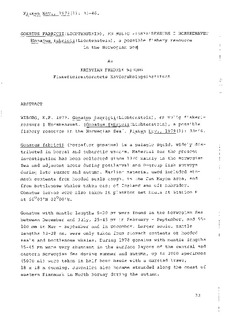| dc.description.abstract | Gonatus fabricii (hereafter gonatus) is a pelagic squid, widely distributed
in boreal and subarctic waters. Material for the present
investigation has been collected since 1970 mainly in the Norwegian
Sea and adjacent areas during postlarval and 0-group fish surveys
during late summer and autumn. Earlier material used included stomach
contents from hooded seals caught in the Jan Mayen area, and
from bottlenose whales taken east of Iceland and off Labrador.
Gonatus larvae were also taken in plankton net hauls at Station M
at 66°00'N 02°00'E.
Gonatus with mantle lengths 6-20 mm were found in the Norwegian Sea
between December and July, 25-45 mm in February - September, and 55-
100 mm in May - September and in December. Larger squid, mantle
lengths 13-28 cm, were only taken from stomach contents of hooded
seals and bottlenose whales. During 1978 gonatus with mantle lengths
15-45 mm were very abundant in the surface layers of the central and
eastern Norwegian Sea during summer and autumn, up to 2000 specimens
(5000 ml) were taken in half hour hauls with a Harstad trawl,
18 x 18 m opening. Juveniles also became stranded along the coast of
eastern Finnmark in North Norway during the autumn.
The correlation between rostral length (RL)of the beak and mantle
length of gonatus has been roughly calculated. In stomach contents
of bottlenose whales caught off Labrador during May - June 1967, the
calculated mantle lengths of gonatus varied from 6 cm to 30 cm,
mostly 13-28 cm.
In the Norwegian Sea spawning and hatching of gonatus probably
occur from December to July, with the peak in April - June. The
main areas of spawning may coincide with localities where bottlenose
whales are abundant as can be seen from catch statistics, e.q. off
eastern Iceland, Møre, Vesterålen and West of Spitsbergen (Fig. 7).
The life cycle of gonatus is probably closely connected to the
current system of the Norwegian Sea and adjacent seas. A fishery for
juvenile gonatus should be tried in these areas, chiefly during
April - August, using trawls, lights and dip nets or pumps; for
larger squid, jigging gear combined with lights should be used. | en |
